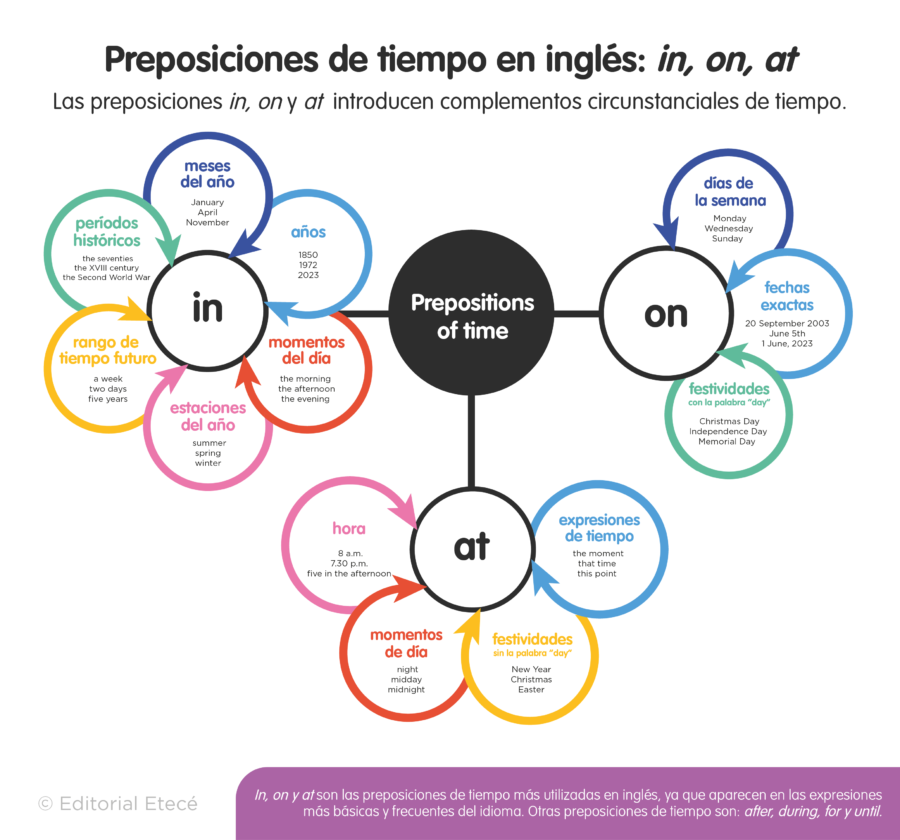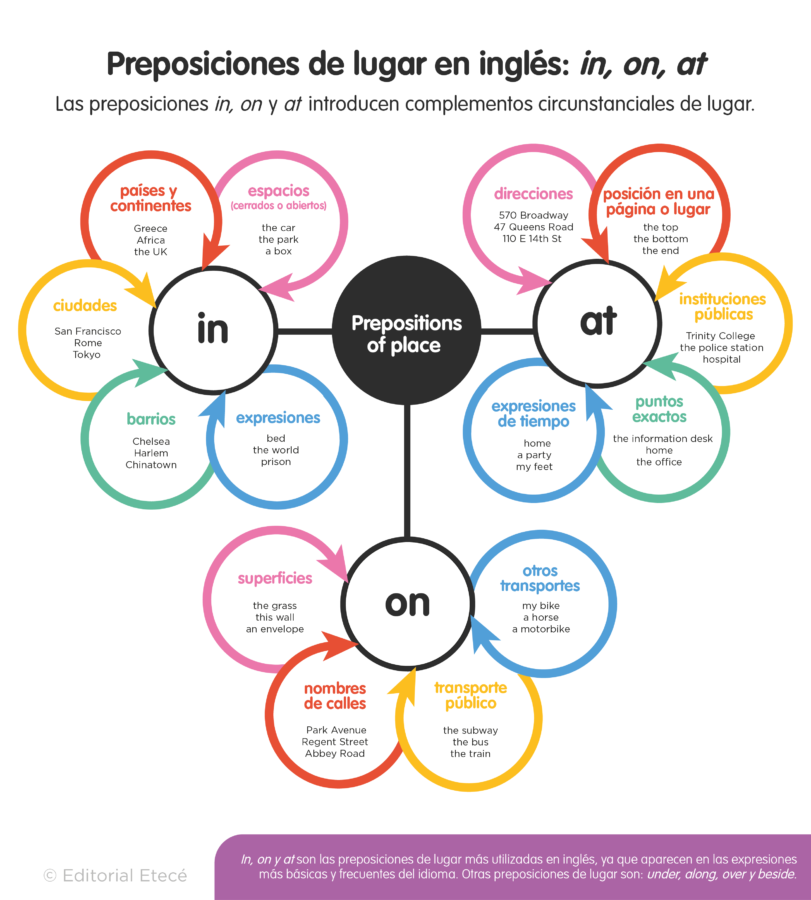Índice
Las preposiciones en inglés, prepositions (in, on, for), son elementos gramaticales que ayudan a establecer una relación entre palabras. Muchas veces no tienen un significado único, sino que varía según el contexto. Por ejemplo: Dad is coming for us at 8 p.m. / Papá vendrá por nosotros a las 8 p.m.
Según el tipo y el contexto, las preposiciones en inglés pueden indicar:
- destino (to)
- procedencia (from)
- lugar (at, in, on)
- finalidad (to, for)
- tiempo (during, since, at)
Las preposiciones en inglés pueden ir antes o después de un sustantivo o frase sustantiva (on the table), después de un verbo (come on), y antes o después de un pronombre (for him).
Preposiciones de tiempo en inglés: Prepositions of time

Las 3 preposiciones más utilizadas son in, on, y at.
¿Cuándo se usa IN? (tiempo)
Cuando se refiere al tiempo, la preposición IN significa “en”:
| Usos de in | Con palabras como… | Ejemplo |
|---|---|---|
| Momentos del día | the morning, the afternoon, the evening | Naomi does yoga in the morning. |
| Meses | March, May | We got married in September. |
| Años | 1995, 2012 | The pandemic broke out in 2020. |
| Estaciones del año | summer, fall, winter, spring | We always go to the beach in the summer. |
| Períodos de tiempo | the nineties, the XV century, the Second World War | Shakespeare was born in the sixteenth century. |
¿Cuándo se usa ON? (tiempo)
Cuando se refiere al tiempo, la preposición ON puede significar “el”, “los” o “en”, según el contexto.
| Usos de on | Con palabras como… | Ejemplo |
|---|---|---|
| Días de la semana | Monday, Friday morning, Saturday afternoon | I take English classes on Mondays and Wednesdays. |
| Fechas | January 1st, September 30th | They’re arriving on December 4th. |
| Algunas festividades (que incluyen la palabra Day) | Christmas Day, Memorial Day, Halloween, Independence Day | We were in New York on Memorial Day. |
¿Cuándo se usa AT? (tiempo)
Cuando se refiere al tiempo, la preposición AT significa “a las”, “a la”, “en”.
| Usos de at | Con palabras como… | Ejemplo |
|---|---|---|
| Hora | 7 a.m., about 5 p.m., 10 in the morning | We usually go to bed at about 11 p.m. |
| Momentos del día | night, midnight, midday, lunchtime | They made the excursion at night. |
| Festividades (que no incluyen la palabra Day) | Easter, Christmas | The family will get together at Easter. |
| Expresiones fijas | that time / moment / point | At that point I realized it was time to go. |
Otras preposiciones de tiempo
Otras preposiciones que se utilizan en relación al tiempo son:
| Preposición de tiempo | Significado | Ejemplo |
|---|---|---|
| about / around | alrededor de … / más o menos a las … | I get up at about 7 a.m. every morning. |
| after | después | We went to eat out after the movie. |
| before | antes | I’ll study every day before the test. |
| between | entre | They always have lunch between 12 p.m. and 2 p.m. |
| beyond | más allá de | Your reservations won’t be held beyond 24 hours. |
| by | para (el), (las) | I have to get this finished by Friday. |
| during | durante | My great-grandfather came to America during WWII. |
| from | desde | Banks in Argentina are open from 10 a.m. to 3 p.m. |
| for | por / durante | Tom has lived in England for a year. |
| past | después | Children, it’s past your bedtime! |
| since | desde | My mother has been working for NASA since 2018. |
| throughout | durante / a lo largo de | He coughed throughout the concert. |
| until | hasta | I’ll be here until 10 p.m. |
| within | dentro de / en menos de | Within 15 minutes of the accident, help had arrived. |
Atención: La preposición by implica una fecha límite; la acción se puede desarrollar antes. Por ejemplo: You need to hand in the report by the end of the week.
Preposiciones de lugar en inglés: prepositions of place

Las preposiciones de lugar que expresan ubicación más utilizadas en inglés son in, on y at. Se utilizan junto a verbos estáticos (que no implican movimiento), be, live, study.
¿Cuándo se usa IN? (LUGAR)
Cuando se refiere al lugar, la preposición IN significa “en”, “dentro”. Implica que la persona o cosa está comprendida dentro de un espacio.
| Usos de in | Con palabras como… | Ejemplo |
|---|---|---|
| Espacios (cerrados o abiertos) | the kitchen, the garden, the city center, the bag, the sea | Can you give me the pen that is in my pencil case? |
| Países | the U.S., France, England | They live in England. |
| Ciudades | New York, Paris, London | I’ll be in London next week. |
| Barrios | West End, Soho, Kensington | Sam studies in Kensington. |
Atención: La preposición in se utiliza además en las siguientes expresiones: in bed, in prison, in the world, in the sky, in a photo, in a car, in the middle of…, in a book, in a newspaper, in a magazine.
¿Cuándo se usa ON? (LUGAR)
Cuando se refiere al lugar, la preposición ON significa “en”, “sobre”. Implica que la persona o cosa no está dentro de un espacio sino está sobre él.
| Usos de on | Con palabras como… | Ejemplo |
|---|---|---|
| Superficies | table, shelf, floor, page | We sat on the grass and had a picnic. |
| Nombres de calle | Kensington Road, Victoria St, 5th Avenue | We bought the flowers at a shop on Kensington Road. |
| Transporte público (excepto taxi) | bus, train, subway, plane, ship | I always read on the bus. |
Atención: La preposición on también se utiliza en: on a bike, on a horse, on a motorbike.
¿Cuándo se utiliza la preposición AT?
Cuando se refiere al lugar, la preposición AT significa “en”. Implica un punto exacto.
| Usos de at | Con palabras como… | Ejemplo |
|---|---|---|
| Direcciones exactas | 720 Victoria St, the Mall, | My friend lives at 12 Oxford St. |
| Puntos exactos | the bus stop, the studio, the door, the traffic lights | I saw Peter at the bus stop. |
| Instituciones y lugares públicos | university, school, the theater, the library | Let’s meet at the library. |
| Posición en una página | the bottom, the top, the end | Please sign at the bottom of the page. |
Atención: La preposición at se utiliza en las siguientes expresiones: at home, at work, at the station, at the airport, at a party / concert / match, at somebody’s house.
Otras preposiciones de lugar
Existen otras preposiciones de lugar, que pueden dar el sentido de:
- Ubicación, si son utilizadas en contextos de verbos estáticos, que no implican movimiento (be, live).
- Movimiento, si son utilizadas en contextos de verbos dinámicos, que implican movimiento (run, go).
| Preposición de lugar | Significado | Ejemplo |
|---|---|---|
| above | sobre / encima de / arriba | During the flood, water rose 2 meters above sea level. |
| across | cruzando, en frente | My grandparents live just across the street. |
| along | a lo largo de / al lado de | I love to run along the beach. |
| around | alrededor de | They have put a fence around the park. |
| against | contra | Please don’t lie back against this wall. |
| behind | detrás / atrás de | The child is hiding behind that wall. |
| beside | junto a / al lado de | Mary is the girl sitting beside Mr. Jones. |
| below | debajo / abajo de | She always wears skirts below the knee. |
| beneath | debajo de / bajo | Beneath that hard exterior lies a sweet kind person. |
| between | entre | At work, I usually sit between Jake and Mel. |
| by | junto a / al lado de | Grandma sits by the fire for hours on end. |
| down | siguiendo por / abajo | Our store is down the road. |
| in front of | delante de / frente a | There’s a tree in front of the house. |
| inside | adentro / dentro | They stayed inside the hotel complex the whole weekend. |
| near | cerca de / junto a | Excuse me, is there a drugstore near here? |
| opposite | justo enfrente | My friend sat opposite me on the train. |
| outside | fuera / afuera de | I’ll be waiting outside the office. |
| over | por encima de / sobre | My mom has ornaments over the fireplace. |
| under | bajo / debajo de | The dog is under the tree. |
| underneath | bajo / debajo | There are many tunnels underneath the city. |
| up | arriba | They have a cottage up the hill. |
| upon | sobre (equivale a on en inglés literario) | The principal had a black cloak upon his shoulders. |
Cuidado:
- Hay preposiciones que son utilizadas exclusivamente con verbos dinámicos, que expresan movimiento (y no ubicación). Estas son: to (a, hacia), through (a través), towards (hacia).
- La preposición in front of significa “delante” y no “en frente” en el sentido literal en español, para lo cual se utiliza across (o opposite) en inglés. Por ejemplo: They live across. (Y no: They live in front).
Otras preposiciones en inglés
Hay otras preposiciones que se utilizan en contextos diversos:
| Preposición | Significado | Ejemplo |
|---|---|---|
| about | alrededor / sobre / acerca de | Bonnie has read an interesting article about butterflies. |
| away from | lejos de | Away from her family she felt lonely and depressed. |
| for | para | We’ve bought a beautiful dress for Margarita. |
| from | de (denota origen o procedencia) | He’s from France. |
| of | de | The leg of the table is broken. |
| off | fuera de / de / cerca | Who’s taken my dictionary off my desk? |
| per | por | He goes to the gym three times per week. |
| to | a / hacia | We’re traveling to the coast next weekend. |
| towards | hacia / a | They headed towards the Capitol. |
| with | con | I went out with my friends last night. |
| without | sin | He’s the best player, without any doubt. |
Atención:
- Existen las phrasal verbs (frases verbales), que son la combinación de un verbo más una preposición (o dos), que juntos forman un nuevo verbo. En esos casos, la preposición forma parte de la phrasal verb, y su significado no debe ser entendido separado del verbo. Por ejemplo: read through (revisar, analizar. Y no: leer a través)
- Las preposiciones pueden aparecer en expresiones fijas, con un sentido idiomático y no literal. Por ejemplo: on my way home (camino a casa).
Test interactivo para practicar
Sigue con:





¿Te fue útil esta información?
Sí No¡Genial! gracias por visitarnos :)